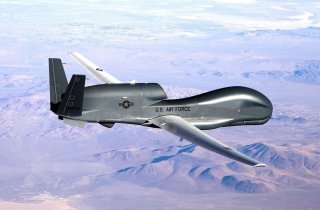In 2019, Iran Shot Down a U.S. Drone (And Almost Started a War)
American technology is tought to beat, but Tehran has managed to hack or shoot down U.S. drones before.
Here's What to Remember: Iranian engineers studied the crashed RQ-170 and quickly produced a crude copy of the radar-evading drone.
U.S. forces on deployment to the Middle East include F-15E fighter-bombers, F-22 and F-35 stealth fighters and B-52 bombers, among others.
But as tensions escalate between the United States and its allies including Saudi Arabia on one hand, and Iran and Yemen’s Iran-backed Houthi rebels on the other hand, it’s worth considering what other American aircraft might be in the region.
The Pentagon maintains an extensive surveillance system in the Persian Gulf region that includes satellites, drones and ground- and sea-based sensors.
Iran’s shoot-down of a U.S. Navy Global Hawk drone in June 2019 put a dent in this system. But it’s possible that other, stealthier drones complement the high-flying but non-stealthy Global Hawks.
In 2010, the U.S. Air Force surveyed an airbase in the United Arab Emirates for the deployment of RQ-170 Sentinel stealth spy drones.
According to heavily-redacted official documents that journalist Joe Trevithick obtained through the Freedom of Information Act, on Sept. 14, 2010, the Air Force’s Air Combat Command circulated an internal memo discussing the “pre-deployment site survey” for placing some of the satellite-controlled RQ-170s at Al Dhafra airbase in the Emirates.
In 2019 Al Dhafra hosts American F-22s, F-35s, F-15Es and other warplanes. The MQ-4C drone that Iran shot down in June 2019 also flew from Al Dhafra.
The small force of flying-wing RQ-170s was busy even before the possible UAE deployment. The 30th Reconnaissance Squadron — a combined Air Force and CIA unit normally based in remote Tonopah, Nevada -- apparently operates all of the roughly 30 RQ-170s that Lockheed Martin built for the Air Force in the early 2000s.
Sentinels helped to spy on Iraq during the 2003 U.S.-led invasion. One of the distinctive, bat-shape ‘bots was photographed by a journalist at Kandahar airfield in 2007. In 2009, the Air Force copped to the Sentinel’s existence, but released no details. An RQ-170 reportedly orbited overhead as Navy SEALs raided Osama bin Laden’s compound in Pakistan in May 2011, killing the Al-Qaeda leader.
In December 2011, one of the 60-foot-wingspan Sentinel drones, probably flying from Kandahar in southern Afghanistan, crashed on the Iran-Pakistan border and was seized by Iranian forces. The Sentinel presumably had been surveilling Iran—specifically, Tehran’s suspected nuclear weapons program.
Iranian engineers studied the crashed RQ-170 and quickly produced a crude copy of the radar-evading drone.
Another version of Air Combat Command’s Sentinel survey memo circulated on Sept. 27, 2010—this one specifying Al Dhafra air base as the stealth drones’ destination. Sentinels, like the non-stealthy Predator and Reaper spy drones also used by the Air Force and CIA, apparently deploy in groups of at least three, allowing one to be airborne over the target area around the clock, while the others are in transit or under repair.
Having surveyed Al Dhafra for Sentinel basing and apparently cleared the massive facility for hosting the secretive robot planes, on Oct. 7, 2010, a U.S. Air Force delegation met with a counterpart group from the UAE Air Force, a strong ally of the American flying branch that operates U.S.-made Predators and F-16s.
The surveys and meeting apparently paved the way for Sentinels to fly from Al Dhafra. The stealthy Sentinel promised to solve what soon became a big problem for U.S. forces around Iran. Tehran’s air force began intercepting American drones near Iranian air space.
In November 2012, an Iranian Su-25 attack jet fired its gun at an MQ-1 Predator but missed. In March 2013, an Iranian F-4 fighter intercepted another Predator but was chased off by an F-22 that slipped in underneath the 1960s-vintage F-4.
The Predators and other spy planes are unable to avoid detection and sometimes need rescuing. But the Sentinels can fly independently, using their hard-to-detect shape and, presumably, radar-absorbing coating to dodge Iranian sensors.
The need for stealth grew only more urgent in 2019 when an Iranian missile knocked an MQ-4C out of the sky. In the aftermath of the shoot-down, it’s a safe bet that radar-evading American drones are flying around Iran.
David Axe served as Defense Editor of the National Interest. He is the author of the graphic novels War Fix, War Is Boring and Machete Squad. This first appeared in September 2019.
Image: Wikipedia.

